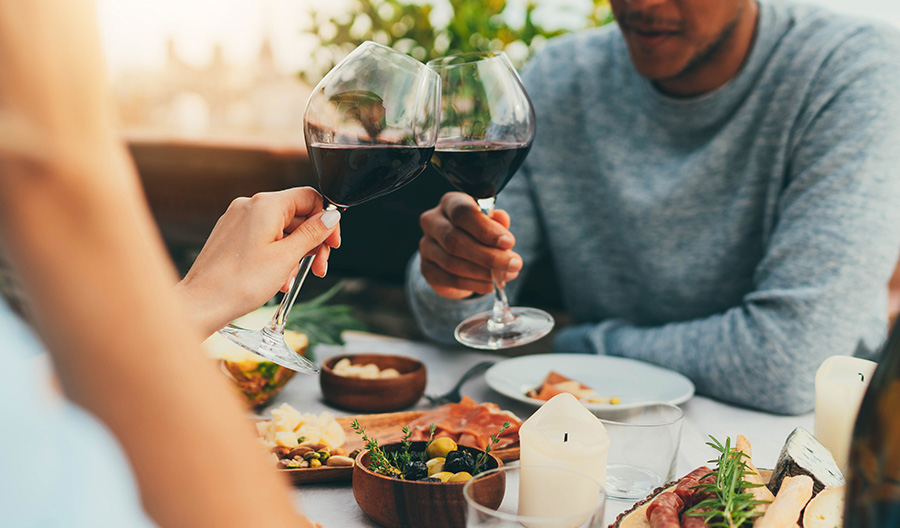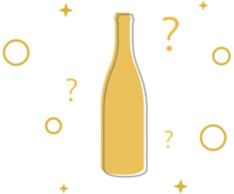If you’ve ever wondered how the flavors of blackberry or raspberry get into a bottle only made from grapes, or how fruity red wine differs from spicy red wine or dark red wine from light-bodied red wine, we’re here to help.
What Is Red Wine?
Starting with the basics, red wine is an alcoholic beverage made by fermenting the juice of dark-skinned grapes. Red wine differs from white wine in its base material and production process. Red wine is made with dark-skinned rather than light-skinned grapes. During red wine production, the winemaker allows pressed grape juice, called must, to macerate and ferment with the dark grape skins, which adds color, flavor, and tannin to the wine. Alcohol occurs when yeast converts grape sugar into ethanol and carbon dioxide. The result of these processes: red wine.
What Are Red Wine Characteristics?
The first and most obvious characteristic of red wine is its color. Red wines range in hue from deep, opaque purple to pale ruby and everything in between. As red wine ages, its bright, youthful colors turn garnet and even brown.
The second characteristic of red wine is tannin. Red wines are made by macerating the juice of grapes with the skins and seeds, and sometimes even the stems as well, which is typically called whole cluster fermentation. All of these elements of the grape bunch impart tannins to the wine.
Tannins are polyphenols that lend texture, structure, and age-ability to a wine. They’re the source of the drying sensation in the mouth akin to black tea. Sometimes tannins are considered ripe, smooth, or well-integrated into the wine, while others may be perceived as rustic, green, or astringent.
Tannins give a wine structure or framework like a skeleton. They soften over time, which is why many consider young, tannic wines best enjoyed after a few years of aging in the bottle.
The third characteristic of red wine is its wide range of flavors. Different grape varieties produce aromas of fruits, flowers, herbs, spices, and earthy characteristics. For example, Pinot Noir tends to have raspberry, cherry, and forest floor notes, while Cabernet Sauvignon generally boasts notes of cassis, licorice, and wet gravel.
These flavors and aromas are not added to the wine, rather they comprise the wine’s unique organoleptic properties derived from organic compounds typically found in acids and grape skins. Red wine characteristics are different from white wine because of the grape type and contact with the skins during maceration and fermentation.
The fourth characteristic of red wine is acid. Acid is an essential component of wine; it serves as a preservative as well as provides freshness and structure. When tasting red wine, the acidity is perceived as the tart and sour attributes which balance against sweet and bitter or tannins components. Red wine has several acid types, though tartaric and malic are the main ones.
Types of Red Wine Grapes
With hundreds of varieties of red wine grapes, there is as much red wine information to learn about as there are red grapes planted in all corners of the globe. That being said, you’ll likely encounter only a handful of these grapes most often. Here, we cover the flavor profiles and regions of the most common red wine grapes. You can certainly choose to discover more beyond this shortlist, but for a quick and easy red wine 101, the following will fit the bill.
Cabernet Franc
Flavors: Violets, blueberry, earth, black olive, coffee
Along with Cabernet Sauvignon and Merlot, Cabernet Franc is part of the essential blending triad that makes up the majority of the Bordeaux blend (and Meritage) red wines produced in the United States. On its own, Cabernet Franc is a more tannic, earthy cousin to Cabernet Sauvignon. In warmer sites outside of Europe, its most distinctive attributes are its pure notes of violets and blueberry, and its ripe tannins often carry the scent of freshly roasted coffee. It is made (though rarely labeled) as a varietal in Chinon, Bourgueil, and Saumur-Champigny, where it is hard and tannic and can evoke an austere minerality. In Pomerol and Saint-Émilion, it is featured in blends with Merlot, adding a spicy, pungent, sometimes minty note.
Cabernet Sauvignon
Flavors: Bell pepper, green olive, herb, cassis, black cherry
The primary component of great Bordeaux and the defining grape of the Napa Valley, Cabernet Sauvignon is grown all over the world, but rarely achieves greatness. It ripens late and can be quite weedy and even vegetal in cooler climate regions such as Chile. In Bordeaux and Tuscany, it is almost always blended to soften its intensely astringent tannins. The Napa-style is dense, purple-black, jammy, and tasting of currants and black cherries. Thick and ripe, layered with expensive new oak scents and flavors, it has almost single-handedly created the phenomenon of the cult wineries. In Washington, the best Cabernet straddles the border between the ripeness of California versions and the nuanced herb, leaf, and olive flavors of great Bordeaux.
Gamay
Flavors: Strawberry, raspberry, cherry
The grape of Beaujolais, Gamay is often made to be drunk quite young and shows bright, tangy, fruit-driven flavors of strawberry, raspberry, and sweet cherries. When made by the method known as carbonic maceration, young Gamay has a slight effervescence and a distinct smell of bananas. Beaujolais Nouveau, released each year shortly after harvest, is the most famous example.

Grenache/Garnacha
Flavors: Spice, cherry
Old vine Grenache makes some of the greatest red wines of both Spain and Australia. An early-ripening grape tends toward high alcohol and low acidity. At its best, it creates very fruitily, spicy, bold-flavored wines somewhat reminiscent of a softer, less-intense version of Syrah.
Malbec
Flavors: Sour cherry, spice
One of the blending grapes of Bordeaux, Malbec has risen to prominence in Argentina, where it makes spicy, tart red wines that take well to aging in new oak barrels. Elsewhere it remains a minor player, though a few varietally labeled Malbecs are made in California and Washington.
Merlot
Flavors: Watermelon, strawberry, cherry, plum
Merlot is the Chardonnay of reds, easy to pronounce, easy to like, agreeable, and versatile, but mostly lacking any substantive character of its own. Varietal Merlot rose to popularity in the 1990s but too many insipid, watery, over-priced Merlots have taken the bloom off the rose. Outside of Bordeaux, it is at its very best in Washington state, where it ripens beautifully and creates plump, powerful wines that can age for a decade or more.
Mourvèdre/Mataro
Flavors: Spice, cherry
This Mediterranean red grape is especially popular in France and Spain, making medium-bodied, lightly spicy wines with pretty, cherry-flavored fruit. The best sites also add a distinctive, gravelly minerality to the fruit. Some old vine plantings of Mourvèdre remain in California and also in Australia, where it is generally featured in a blend with Shiraz and Grenache.
Nebbiolo
Flavors: Plum, pie cherry, tar
The principal grape of Barolo, Barbaresco, and Gattinara (all made in the Piedmont region of Italy), Nebbiolo unquestionably belongs with the great red wines of the world but has proven almost impossible to grow anywhere else. California versions, despite decades of effort, remain light, thin and generic.
Pinot Noir
Flavors: Tomato leaf, beetroot, pale cherry, blackberry, cola, plum
Pinot Noir is the grape that winemakers love to hate; it is the prettiest, most demanding, and least predictable of all. The template for great Pinot Noir is Burgundy, but even there the grape is flighty, fragile, and prone to obstinately weedy flavors. It is a principal component of many Champagnes and other sparkling wines, but can also be ripened to produce wines of surprising density and even jamminess in California, New Zealand, and warm sites in Oregon. Pinot Noir is best expressed as a pure varietal and is often featured as a single-vineyard wine in Oregon and California, emulating the hundreds of tiny appellations of Burgundy. When at its best, Pinot has an ethereal delicacy yet can age for decades; it is most memorably described as “the iron fist in the velvet glove.”
Sangiovese
Flavors: Pie cherry, anise, tobacco leaf
The principal grape of Tuscany, where it is the primary component of Chianti and Brunello di Montalcino. Sangiovese is relatively light in color and quite firmly acidic. In Italy it shows distinctive flavors of pie cherry, anise, and tobacco; elsewhere it can be rather plain and undistinguished, though some promising bottles have come from Washington’s Walla Walla Valley. Many of Italy’s “Super Tuscan” red blends marry Sangiovese to Cabernet Sauvignon, a combination that both strengthens the Sangiovese and smooths out the Cabernet.
Syrah/Shiraz
Flavors: Blackberry, boysenberry, plum, pepper, clove
Plantings of Syrah have exploded in California and Washington, where sappy, spicy, peppery, luscious versions are being made. Known as Shiraz in Australia, it is unarguably that country’s claim to enological fame. Australian Shiraz is made in every conceivable style, from light and fruity to dense and tarry; it is made as a deep red, tannic sparkling wine, and also as a fortified “Port”. In the northern Rhône, the most extraordinary expressions of the grape are produced, especially in Hermitage and Côte Rôtie, where its peppery, dense, spicy fruit is layered into unbelievably complex wines streaked with mineral, smoked meat, tar, wild herb, and leather.
Zinfandel
Flavors: Raspberry, blackberry, black cherry, raisin, prune
For decades Zinfandel as California’s grape, though now it is grown all over the west coast of the United States, in Australia, Italy, and elsewhere, and its ancestry has been traced to Croatia. But California Zinfandel remains the model for all others, and it grows well and vinifies distinctively all over the state. Mendocino makes somewhat rustic versions with hints of Asian spices; Dry Creek Zinfandels are racy and laden with raspberry. In Amador and Gold Rush country it is hot, thick, and jammy, while in Napa it is plush with ripe, sweet black cherry flavors. California Zinfandels now commonly reach 15 or 16 percent alcohol levels; sometimes even higher for late harvest versions. Zinfandel “Ports” are also made.
Red Wine & Food Pairings
Red wine’s diverse styles and structure make it the ideal choice for the dinner table. Red wine has a firmer structure than typical white and rosé wines supporting it when coming up against strong flavors. Steak and Cabernet is the tried and true pairing, fuller-bodied red wines in general pair well with denser, heavier foods, while lighter-bodied reds with high acidity pair well with lighter fare, like roasted chicken and vegetable dishes. Matching the weight of the wine with the richness of the food leads to successful and harmonious pairings.
The old adage, “what grows together, goes together” holds true as well. For example, traditional tomato sauce Italian dishes pair well with the high-acid red wines of Chianti. In general, a region’s wine will pair well with the food and lifestyle of the area.
Red Wine’s Ageability
Red wine is heralded for its age-ability, but in order for a wine to age to its full potential, it must be stored properly. Factors that affect the aging process are temperature, light, and humidity. Red wines should be stored at about 55° Fahrenheit, 10° F below the ideal serving temperature.
Wines stored too warm will accelerate the aging process, while wines stored in hot temperatures, above 75° Fahrenheit can be “cooked,” causing the fruit flavor characteristics to turn mushy and baked. A red wine stored too cold can also damage the wine but is generally not as dangerous as overheating the wine. Low temperatures slow the aging process, but if your wine doesn’t freeze, there likely won’t be any extensive damage. Colder temperatures, like a 40° Fahrenheit refrigerator, are fine for short-term storage. Wines that freeze pose their own problems. As the liquid freezes, it expands and can push the cork out, compromising the wine, or worse, cracking the bottle. While small changes in temperature are safe, it’s important to keep your wines at the most consistent temperature possible.
Red wines are bottled in green or brown-tinted bottles to protect them from harmful ultraviolet (UV) rays. Light-bodied wines are at a greater risk of being spoiled by light than full-bodied wines, but it’s best to avoid any long-term exposure to light, both natural and artificial. UV rays can break down compounds in the wine causing it too age more rapidly, and light carries damaging heat as well.
A delicate balance of humidity is also vital to red wine storage. Wines kept in a dry environment put the cork at risk, if the cork dries out it can shrink and allow oxygen to seep into the bottle or wine to leak out.
Red Wine Stemware
There are many different wine glasses on the market from traditional to quirky. While a fun-shaped or designed glass can be great for less formal occasions, having the proper glass will enhance your wine-drinking experience. There are two main shapes for red wine glasses: the tall, tapered Bordeaux glass and the wide bowl Burgundy glass. The tall, narrow Bordeaux glass has a tapered opening that concentrates the aromas of the wine. Its height creates distance between the wine and your nose, allowing sharp, burning ethanol aromas to dissipate. The Bordeaux glass should be used for fuller-bodied, higher alcohol wines with spicier notes and is traditionally used with the Cabernet and Merlot-based wines of Bordeaux. The wide bowled Burgundy glass is best implemented when drinking lighter-bodied reds with more delicate aromas. The shape of the bowl helps trap and concentrate the aromas. Regardless of shape, wine glasses should be stemmed to prevent heat from hands being transferred to the wine.
There are numerous ways to cook with red wine. Whether you use it to glaze, braise or even boil pasta, choosing the right wine can be difficult. Forget the cooking wine. Grocery store cooking wine often has other additives like salt and should be avoided. Luckily most recipes offer suggestions for the style of wine to be implemented, even if it is as vague as “dry wine”. If a recipe calls for 1 cup of wine, consider purchasing a half bottle, which contains a little over one and a half cups of wine. Be sure to consider the dish when selecting the wine. If you are only deglazing the pan, leftover wine from the past few days will work fine. However, if wine is a key flavor component to the dish, the wine you select will have a greater impact. Dry wines should be used for savory dishes while sweet wines are better for desserts. When in doubt, select a dry red wine with low to moderate tannins to complement most dishes. Always cook with wine you wouldn’t mind drinking as the quality of the wine will affect the flavors of your dish.

